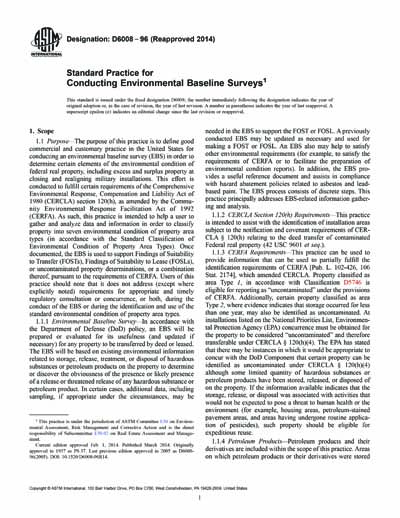Historical
ASTM D6008-96(2014)
Standard Practice for Conducting Environmental Baseline Surveys
1.1 Purpose—The purpose of this practice is to define good commercial and customary practice in the United States for conducting an environmental baseline survey (EBS) in order to determine certain elements of the environmental condition of federal real property, including excess and surplus property at closing and realigning military installations. This effort is conducted to fulfill certain requirements of the Comprehensive Environmental Response, Compensation and Liability Act of 1980 (CERCLA) section 120(h), as amended by the Community Environmental Response Facilitation Act of 1992 (CERFA). As such, this practice is intended to help a user to gather and analyze data and information in order to classify property into seven environmental condition of property area types (in accordance with the Standard Classification of Environmental Condition of Property Area Types). Once documented, the EBS is used to support Findings of Suitability to Transfer (FOSTs), Findings of Suitability to Lease (FOSLs), or uncontaminated property determinations, or a combination thereof, pursuant to the requirements of CERFA. Users of this practice should note that it does not address (except where explicitly noted) requirements for appropriate and timely regulatory consultation or concurrence, or both, during the conduct of the EBS or during the identification and use of the standard environmental condition of property area types.
1.2 Objectives—Objectives guiding the development of this practice are (1) to synthesize and put in writing a standard practice for conducting a high quality EBS, (2) to facilitate the development of high quality, standardized environmental condition of property maps to be included in an EBS that can be used to support FOSTs, FOSLs, and other applicable environmental condition reports, (3) to facilitate the use of the standard classification of environmental condition of property area types, and ( 4) to facilitate the development of a standard guide for preparing and updating EBS reports.
1.3 Limitations—Users of this practice should note that, while many of the elements of an EBS are performed in a manner consistent with other “due diligence” functions, an EBS is not prepared to satisfy a purchaser of real property's duty to conduct an “appropriate inquiry” in order to establish an “innocent landowner defense” to CERCLA § 107 liability. Any such use of any EBS by any party is outside the control of the United States Department of Defense and its components and beyond the scope of any EBS. No warranties or representations are made by the United States Department of Defense, its components, its officers, employees, or contractors that any EBS Report satisfies any such requirement for any party.
ASTM International [astm]

